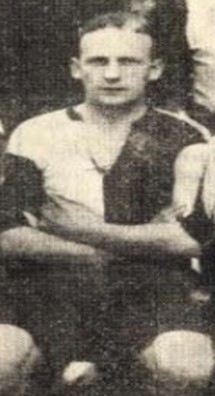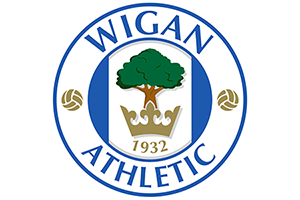Benny Jones - Player Profile

| Full Name: | George Benjamin Jones |
| Born: | 29/01/1907 |
| Died: | 01/01/1982 (age 74) |
| Place of Birth: | Newtown |
| Nationality: | Wales |
| Height: | 5 ft 10 in |
| Position: | Defence |
| Signed: | 03/09/1932 (Free) |
| Left: | 31/05/1933 (Free) |
Early Life and Introduction to Football (Newtown and Bolton Wanderers)
Birth and Early Years: George Jones was born in Newtown, Wales, and it was with his hometown club that he likely took his first steps in competitive football. In 1926, as a 19-year-old, Jones was involved with Newtown A.F.C. (a Welsh club), although records of his appearances at Newtown are not clearly documented (likely because detailed statistics from that period in Welsh football are scarce). His early potential soon attracted attention from clubs in the English system.
Bolton Wanderers (1927–1928): In 1927 Jones moved to England to join the Bolton Wanderers. However, he did not break into Bolton’s first team and made no Football League appearances for the club during the 1927–28 season. He spent his time at Bolton in the reserves or on the books as a developing player. This experience, nevertheless, placed him in a professional environment and set the stage for future opportunities.
Seeking Opportunities In Scotland: Hamilton Academical (1928–1930)
Finding limited chances in England, Jones crossed the border to Scotland in search of playing time:
Hamilton Academical (1928–1930): In the summer of 1928, Jones signed with Hamilton Academical (often nicknamed “Accies”), a club in the Scottish League. He remained with Hamilton from August 1928 until May 1930. While he was part of Hamilton’s squad, his first-team league appearances are not clearly recorded, suggesting he may have played mostly in the reserves or not featured significantly in official league matches. (Indeed, his name does not appear on Hamilton’s list of players with league appearances, indicating he likely did not play in a league game for the Accies.) Despite the lack of documented games, the experience in Scotland would have contributed to his development, keeping him match-fit for the opportunities that soon followed back in England.
Football League Debut: Swindon Town (1930–1931)
Returning from Scotland, Jones earned a chance in the English Football League with Swindon Town in the 1930–31 season:
Swindon Town (1930–1931): Jones joined Swindon Town (then competing in the Third Division South). He made his English Football League debut with Swindon during the 1930–31 season, where he registered 4 league appearances and scored 1 goal. This tally indicates that while he was not a regular starter, he did manage to make an impact by getting on the scoresheet. Swindon Town’s archives confirm Jones’s limited but notable contribution: he featured in four first-team matches and found the net once. This goal – the first recorded in his senior career – would have been an important milestone for the aspiring forward.
Swindon Town’s 1930–31 campaign saw them finish mid-table in Division Three (South), and though Jones’s role was peripheral, his time at Swindon provided valuable Football League experience. By the season’s end, he moved on in pursuit of more regular playing opportunities.
Rising in the Ranks: Rochdale A.F.C. (1931–1932)
Jones’s next move was to Rochdale A.F.C., offering him more consistent game time in the Football League Third Division North:
Rochdale: Jones signed for Rochdale in the 1931–32 season. He became a part of Rochdale’s forward line from August 1931 up to March 1932. During his spell at Rochdale, he made 19 league appearances and scored 3 league goals, with 20 appearances and 3 goals in all competitions. Listed as “Benny Jones” (indicating his commonly used nickname), he is noted among Rochdale players of that era as an English forward with 20 games and 3 goals in 1931–32.
Rochdale’s records show that Jones was a moderately used squad member, contributing a few goals. The 1931–32 season was challenging for Rochdale, and they utilized many players with under 25 appearances – Jones among them. He managed to get on the scoresheet three times, demonstrating an ability to contribute offensively when given the chance.
By March 1932, Jones’s time at Rochdale came to an end, but his solid performances (including those 3 goals) paved the way for a move to a higher-division club before the season was over.
Stepping Up Briefly: Oldham Athletic (1932)
Jones’s form at Rochdale earned him a short-term move to Oldham Athletic, another Third Division North club with bigger ambitions:
Oldham Athletic : In March 1932, towards the latter part of the 1931–32 season, George “Benny” Jones signed for Oldham Athletic. At Oldham, however, his involvement was brief – he made 2 league appearances for the Latics (Oldham’s nickname) before the season ended. He did not score in those two outings.
Oldham Athletic’s records list “Benny Jones” as having played two matches in 1932. Although his stint at Oldham was short, it’s noteworthy that Oldham were a historically significant club (they had been in the top flight a decade earlier). Even a couple of appearances for such a club would have been valuable experience for Jones. By the summer of 1932, despite the limited chances at Oldham, a new and defining chapter awaited him at a brand-new club forming in the football world.
The Wigan Athletic Chapter (1932–1933)
Perhaps the most important chapter in Jones’s career came with the birth of Wigan Athletic. The club was newly formed in 1932 following the collapse of Wigan Borough, and Jones became part of Wigan Athletic’s first-ever squad:
George “Benny” Jones joined Wigan Athletic in September 1932 on a free transfer from Oldham. This was just as Wigan Athletic was starting out in the 1932–33 season, their inaugural season in the Cheshire County League (a semi-professional English league). Jones quickly became a key squad member for Wigan, showcasing his versatility by playing both in defense (left-back) and attack (inside-left) as needed.
Appearances: Jones played 29 league matches out of 42 for Wigan in 1932–33. He was one of the regulars; only a few players made more appearances that season.
Goal Scoring: Despite often featuring in defense, Jones had a knack for scoring. He netted 8 league goals for Wigan Athletic during the 1932–33 campaign. Wigan Athletic as a team scored prolifically (121 league goals) and Jones contributed significantly to that haul. Notably, Jones even scored a hat-trick in one of the matches, underlining his attacking prowess.
Role in Team: Wigan Athletic’s inaugural season was a successful one. Jones was part of a side that finished 5th in the Cheshire County League (with 21 wins and 121 goals scored).
Jones’s teammates that season included high-scoring forwards like Bill Chambers and Barney McCabe . Jones’s 8 league goals put him behind the top scorers but still as a valuable contributor. Throughout the season, he often featured in match reports for his solid play and occasional goals from the flanks or defense.
By the end of the 1932–33 season, Wigan Athletic underwent significant turnover – only two players were retained for the next season as the club looked to build on its initial success. Jones was among those who departed in the summer of 1933, leaving Wigan on 31 May 1933 after a single, memorable season with the club.
Later Career Moves: Nelson, Southend United, and Horwich “RMI” (1933–1936)
After leaving Wigan Athletic, Jones’s career became somewhat peripatetic, as he moved frequently, including spells in non-league football and brief returns to the Football League:
Nelson F.C. (1933–1934): In the 1933–34 season, Jones signed with Nelson F.C. Nelson was a Lancashire club that had been in the Football League in the 1920s but by 1933 had fallen into non-league (Lancashire Combination) football. Jones played for Nelson throughout the 1933–34 season. While detailed records of Nelson’s 1933–34 campaign are limited, Jones was a member of their squad and likely a regular given his experience.
Southend United (1934–1935): Jones returned to the English Football League in 1934 by joining Southend United, a Third Division South club. In the 1934–35 season, he made 4 league appearances for Southend United. His time at Southend was brief and he did not score any goals in those matches. Southend’s squad in 1934–35 was managed by David Jack (the famous former Arsenal and Bolton player-manager) and they used Jones sparingly. By the end of the season, Jones moved on, but Southend records do note his contribution of four games in that campaign. (Southend United finished 16th in Division Three South that season, and Jones was one of numerous players who made only a handful of appearances.)
Horwich RMI (1935–1936): In 1935–36, Jones joined Horwich RMI. Horwich RMI was a non-league club in the Lancashire Combination and later Cheshire County League (and is the club that decades later became Leigh RMI).
Unfortunately, specific stats here are unknown, as local league record-keeping was patchy.
Journeyman Years: Shrewsbury Town and the Northern Irish Adventure (1936–1939)
As he approached his 30s, Benny Jones embarked on a series of short-term stints, including a notable move to Northern Ireland’s football scene:
Shrewsbury Town (1936–1937): In the 1936–37 season, Jones briefly played for Shrewsbury Town. At that time, Shrewsbury was a non-league club (they did not join the Football League until after World War II). Jones’s spell at Shrewsbury was within the 1936–37 season, but like many of his moves, it was short-lived (perhaps only the first part of the season). Shrewsbury Town competed in regional English leagues; records from that period are sparse, so no precise appearance figures are available for Jones. It’s likely he was involved in some Midland or regional league matches for Shrewsbury before moving on.
Move to Northern Ireland (1936–1939): Benny Jones’s career then took an interesting turn as he moved to play for clubs in Northern Ireland, indicating his willingness to travel for the game:
Portadown (1936–1937): During the 1936–37 season, after his time at Shrewsbury, Jones joined Portadown. Portadown is a Northern Irish club that at the time played in the Irish League (top division of Northern Irish football). It was common for British players to be lured to Irish clubs with the promise of regular play and sometimes employment. Specific match data isn’t readily available, but he would have competed in the Irish League and Cup competitions. Portadown were a strong provincial club, and having a player with Football League experience like Jones would have been valuable.
Crusaders (1937 & 1938–1939): Jones also played for Crusaders F.C., a club based in Belfast. In fact, he had two separate spells with Crusaders. The first was in late season 1936/7. Crusaders in that era were members of the Irish Intermediate League (they didn’t join the top-flight Irish League until 1949), but they were a competitive side in Belfast. Jones’s impact at Crusaders would have been as an experienced versatile player adding quality. He then rejoined Crusaders for a second spell in the 1938–39 season.
Bangor (1937–1938): In between his Crusaders stints, Jones spent the 1937–38 season at Bangor. Bangor F.C. (the Northern Irish club from County Down, not to be confused with Bangor City in Wales) played in the Irish Intermediate League as well. Jones featured for Bangor in 1937–38, bringing veteran savvy to the team. Bangor would later join the Irish League in the 1940s, but in Jones’s time they were a strong intermediate club. His one-season stay at Bangor was part of the nomadic late phase of his career.
In summary, from 1936 onward, Jones hopped between Shrewsbury (England) and three Northern Irish clubs: Portadown, Crusaders, and Bangor. This suggests that by his early 30s, he was likely following short-term contracts or opportunities, possibly influenced by the political/economic situation (clubs in Northern Ireland sometimes offered better wages or jobs in those pre-war years). His versatility and experience were selling points, even if he stayed only a season or less at each club.
Legacy and Life After Football
By the outbreak of World War II in 1939, George “Benny” Jones’s known football journey comes to a close. As leagues were suspended for the war, Jones, being in his early 30s, likely retired from playing around this time. There isn’t documentation of him returning to professional football after WWII, so it’s presumed he hung up his boots during or just before the war.
Later Life: Information on Jones’s post-football life is limited. Given that he died on 1 January 1982 at age 74, he lived long after his football days but outside of the limelight. It’s possible he returned to Wales or settled in one of the communities he played in (perhaps Wigan or Northern Ireland). No records indicate him taking up coaching or managerial roles, so he may have led a private life after playing. His legacy largely lives on in the archives of the many clubs he served.
Wigan Athletic Career
| League | FA Cup | League Cup | Other | Total | |||||||
|---|---|---|---|---|---|---|---|---|---|---|---|
| Season | Apps | Goals | Apps | Goals | Apps | Goals | Apps | Goals | Apps | Goals | |
| 1932-1933 | 29 (0) | 8 | 0 (0) | 0 | 0 (0) | 0 | 5 (0) | 3 | 34 (0) | 11 | |
| TOTALS | 29 (0) | 8 | 0 (0) | 0 | 0 (0) | 0 | 5 (0) | 3 | 34 (0) | 11 | |


